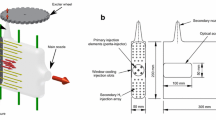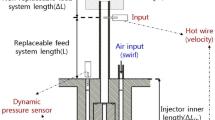Abstract
A scaling method to examine combustion-stability characteristics of a coaxial injector is devised based on the acoustics and combustion dynamics in a chamber. The method is required for a subscale test of stability rating with a model chamber, which is cost-effective compared with an actual full-scale test. First, scaling and similarity rules are considered for stability rating and thereby, three conditions of acoustic, hydrodynamic, and flame-condition similarities are proposed. That is, for acoustic similarity, the natural or resonant frequencies in the actual chamber should be maintained in the model chamber. And, two parameters of density ratio and velocity ratio are derived for the requirement of hydrodynamic and flame-condition similarities between the actual and the model conditions. Next, one example of an actual combustion chamber with high performance is selected and the proposed scaling method is applied to the chamber for understanding of the method. The design operating condition for a model test is presented by mass flow rates of propellants. Stability boundaries can be identified on the coordinate plane of chamber pressure and mixture ratio of fuel and oxidizer by applying the scaling method.
Similar content being viewed by others
References
F. E. C. Culick and V. Yang, in liquid rocket engine combus tion instability (Edited by V. Yang and W. E. Anderson), Progress in Astronautics and Aeronautics, Vol. 169, AIAA, Washington DC (1995) 3–38.
S. C. Fisher, F. E. Dodd and R. J. Jensen, in liquid rocket engine combustion instability (Edited by V. Yang and W. E. Anderson., Progress in Astronautics and Aeronautics, Vol. 169, AIAA, Washington DC (1995) 545–564.
D. J. Harrje and F. H. Readon (eds.), Liquid propellant Rocket Combustion Instability, NASA SP-194 (1972).
D. K. Huzel and D. H. Huang, Modern engineering for design of liquid-propellant rocket, Vol. 147, Progress in Astronautics and Aeronautics, AIAA, Washington, DC (1992) 35.
G. P. Sutton, History of liquid-propellant rocket engines in Russia, formerly the Soviet Union, Journal of Propulsion and Power 19 (2003) 1008–1037.
C. E. Dexter, M. F. Fisher, J. R. Hulka, K. P. Denisov, A. A. Shibanov and A. F. Agarkov, Scaling techniques in liquid rocket engine combustion devices testing, The Second International Symposium on Liquid Rocket Engines, ONERA, Paris (1995).
C. H. Sohn, W. S. Seol, A. A. Shibanov and V. P. Pikalov, On the method for hot fire modeling of high-frequency combustion instability in liquid rocket engines, Journal of Mechanical Science and Technology, 18(6) (2004) 1010–1018.
C. H. Sohn, W. S. Seol, A. A. Shibanov and V. P. Pikalov, Combustion stability boundaries of the subscale rocket chamber with impinging jet injectors, Journal of Propulsion and Power, 23(1) (2007) 131–139.
J. S. Kim and F. A. Williams, Boundaries of acoustic instability in liquid-propellant rocket engines: A theoretical explanation of an empirical correlation, Journal of Propulsion and Power, 12(3) (1996) 621–624.
J. H. Im, S. H. Cho and Y. B. Yoon, Comparative study of spray characteristics of gas-centered and liquid-centered swirl coaxial injectors, Journal of Propulsion and Power, 26(6) (2010) 1196–1204.
J. Jeon, M. Hong, Y.-M. Han and S. Y. Lee, Experimental study on spray characteristics of gas-centered swirl coaxial injectors, Journal of Fluids Engineering, 133 (2011) 121303–1-7.
V. P. Pikalov, A. A. Shibanov, A. A. Narizhny and A. K. Nedashkovsky, Development of different configurations of model injectors, injection elements and damping devices. acoustic characterization of model combustion chamber with different damping devices installed, Research institute of chemical machine building (NIICHIMMASH), Progress Rept. No. 512-2002-03, Moscow, Russia (2002).
C. H. Sohn, I. S. Park, S. K. Kim and H. J. Kim, Acoustic tuning of gas-liquid scheme injectors for acoustic damping in a combustion chamber of a liquid rocket engine, Journal of Sound and Vibration, 304(5) (2007) 793–810.
J. H. Park and C. H. Sohn, On optimal design of half-wave resonators for a acoustic damping in an enclosure, Journal of Sound and Vibration, 319 (2009) 807–821.
E. Laudien, R. Pongratz, R. Pierro and D. Preclik, Experimental procedures aiding the design of acoustic cavities, Liquid Rocket Engine Combustion Instability, edited by V. Yang and W. E. Anderson, Vol. 169, Progress in Astronautics and Aeronautics, AIAA, Washington, DC (1995) 377–399.
S. E. Schmidt and P. O. Hedman, CARS temperature and lda velocity measurement in a turbulent, swirling, Premixed Propane/Air Fueled Model Gas Turbine Combustor, ASME 95-GT-64 (1995).
K. B. Ahn, Y. M. Han, S. H. Seo and H. S. Choi, Effects of injector recess and chamber pressure on combustion characteristics of liquid-liquid swirl coaxial injectors, Combustion Science and Technology, 183(3) (2010) 252–270.
C. J. Kim and C. H. Sohn, An experimental study on stability rating of impinging-jet injectors using air injection in a subscale chamber, Journal of Mechanical Science and Technology, 26(6) (2012) 1963–1970.
Author information
Authors and Affiliations
Corresponding author
Additional information
Recommended by Associate Editor Oh Chae Kwon
Chae Hoon Sohn received his B.S., M.S., and Ph.D in Mechanical Engineering from Seoul National University, Korea, in 1992, 1994, and 1998, respectively. He worked at Korea Aerospace Research Institute and Chosun University in 1999 to 2007. He is currently a professor in Department of Mechanical Engineering at Sejong University in Seoul, Korea. His research interests are in the area of combustion, rocket propulsion, and acoustics.
Young Jun Kim received his B.S. in Aerospace Engineering from Chosun University, Gwangju, Korea in 2010. He is currently a graduate student in Department of Mechanical Engineering at Sejong University, Seoul, Korea in 2012. His research interests are in combustion and rocket propulsion.
Rights and permissions
About this article
Cite this article
Sohn, C.H., Kim, Y.J., Kim, YM. et al. A scaling method for combustion stability rating of coaxial gas-liquid injectors in a subscale chamber. J Mech Sci Technol 26, 3691–3699 (2012). https://doi.org/10.1007/s12206-012-0843-3
Received:
Revised:
Accepted:
Published:
Issue Date:
DOI: https://doi.org/10.1007/s12206-012-0843-3




